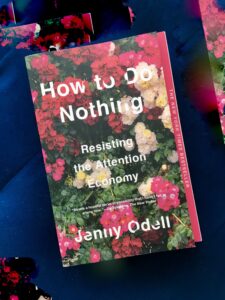Since finishing Jenny Odell’s fascinating book, HOW TO DO NOTHING: RESISTING THE ATTENTION ECONOMY, I’ve spotted a red-bellied woodpecker (twice) on our backyard birdfeeder, identified that curious grey-capped hopper foraging in the rose bushes as a catbird (thanks, SK!), watched a red-tailed hawk hunt (and shit!) in a church’s backyard while waiting to pick up takeout Chinese food, and, this morning, looked out the kitchen window to find two young white-tailed deer skittishly picking their way across our neighbors’ yards. Each time I’ve been tempted to run for my phone and each time I’ve stayed put—just watching.
As most of you know, I renounced the attention economy, after slowly extracting itself from it, late last year. Not too long ago, I gave up my final foothold and deleted my Facebook account. My gut urge to run for my phone—and the camera within it—hasn’t dissipated, even with this much time. This urge, leftover from the “hey, look at me” trap I felt while engaging in social media is, I’m guessing, an inherently natural one: I want my community, however far flung we may be, to see what I’m seeing.
Odell’s book surprised me, in the best possible way. It’s been on my list since it came out, but I rarely buy hardcovers and it wasn’t until I was browsing a local bookstore last month that I saw it had arrived in paperback. (Browsing local bookstores! How I’ve missed you!) I knew a little about what to expect—resisting the attention economy sounds write up my alley, maybe especially since I’ve gone the full-resistance route—and was pleasantly wowed by all that I wasn’t expecting.
The book, far from being a manifesto on “doing nothing” or giving up social media, is an exercise in seeing. Really seeing, and listening, and feeling, and smelling, and being. Odell pitches this—successfully—as resistance. She catalogs artists and exhibits, music, literature, historical movements, ecological biodiversity, as pathways into ideas of how humans can and should exist in an increasingly techo-controlled world. Among the ideas that most resonated with me is her meditation on context, in the final chapter (“Restoring the Grounds for Thought”). She writes,
“[P]ractices of close attention can help us see into nuanced ecologies of being and identity. This kind of understanding has a few important requirements. First it asks usto loosen our grip on the idea of discrete entities, simple origin stories, and neat A-to-B causalities. It also requires humility and openness, because to seek context is already to acknowledge that you don’t have the whole story. …Context is what appears when you hold your attention open for long enough; the longer you hold it, the more context appears.” [emphasis mine]As a writer (and, let’s face it, as a human) I spend a lot of time thinking about context. I’m always looking for how things are connected, drawing invisible lines between all that I experience around me, and my self within that sphere. It wasn’t until I read Odell’s take on the “context collapse” that occurs on social media platforms, that I was able to articulate what so rankled each time I browsed my Twitter feed or logged in to Instagram: I was (we are) being asked to give up the spatial and temporal contexts that are so important to how our brain processes information.
Odell isn’t anti-tech, or even anti-social media: she recognizes the benefits of what the social internet has brought us—she’s just encouraging us to remember that the internet is a tool, and no tool—no matter how expansive—is all purpose. This book is a reminder of ALL the reasons why it’s a good idea to put down your phone, and look around, to experience life without a filter, as often as possible. And it’s a reminder of the inherent value of the world around you—the place you find yourself in and whom you share it with.
*

